Screen Time for Mac: Everything You Need to Know
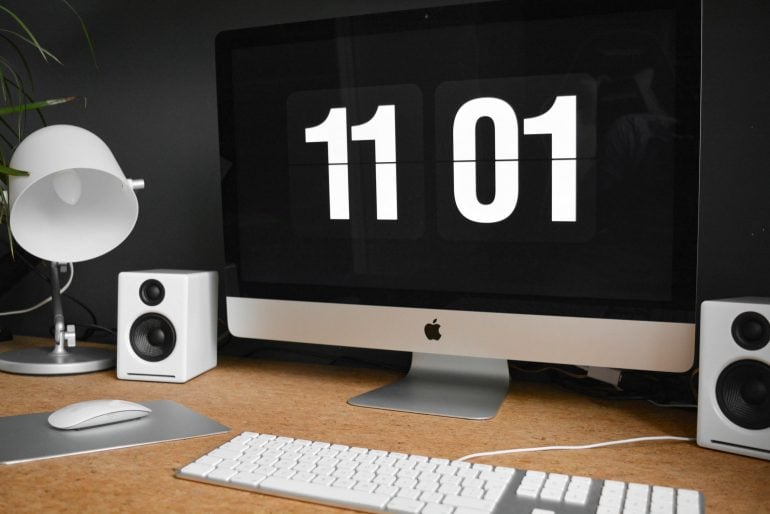 Image source: Damian Patkowski
Image source: Damian Patkowski
Being aware of how we spend our time can help us be more productive and focused. By revealing patterns of behavior, it can also help us to find a balance between the time we spend on different activities. But how do we know where our time is going? Using a time tracking tool such as Screen Time for Mac is a useful place to start. (But, it’s not the only option!)
Screen Time was an iPhone and iPad feature first, but it’s been available across all Apple devices, including Macs, for some time. Mac Screen Time first came out with macOS 10.15 Catalina, and has continued to be available on all subsequent versions, including macOS 11 Big Sur, macOS 12 Monterey and macOS 13 Ventura.
Table of Contents
TOC
What is Screen Time for Mac?
 Image source: Trust “Tru” Katsande
Image source: Trust “Tru” Katsande
Screen Time Mac is a built-in feature that tells you how much time you spend on your device every day and which apps you use the most.
This information can be surprising, even shocking, to some of us — and if we use it correctly, it can also be lucrative. Do we really spend that much time on social media, for example? And what about all those hours we’re on our email? Are there billable hours hidden in that time that we could be charging for?
Screen Time’s high-level overview of where our time goes is just the beginning, however. This useful tool also offers insight into which apps are notifying you the most (emails and WhatsApp desktop notifications are often the biggest culprits here). And it tells you which apps you go to first after waking your computer up (these are called “Pickups”).
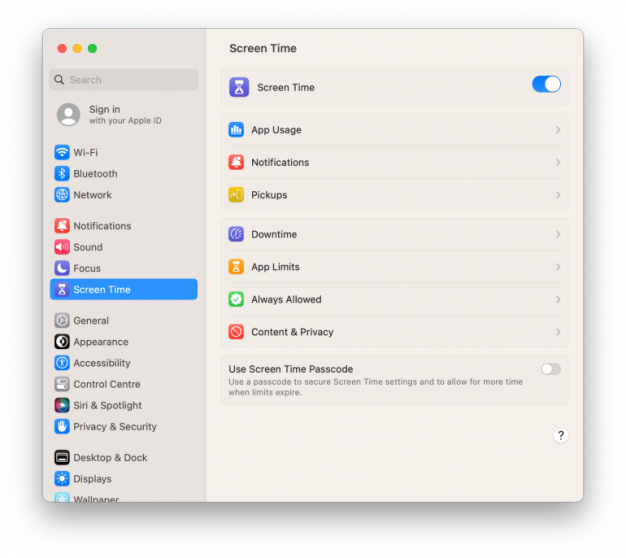
Perhaps most importantly, Screen Time allows you to schedule time away from your screen, and to limit the time you spend on apps. Having some downtime, particularly at night, can help to improve the quality of your sleep. And limiting your apps can help you avoid those you find particularly distracting.
You can even set detailed limits so that you can’t use certain apps or websites during your working hours. This is handy if you’re prone to shopping on Etsy when you should be sending invoices, or editing your photos when you should be writing a proposal. Make these apps available after 5pm and give your productivity a boost.
(And yes, you can add more screen time to an app limit when it expires. When you hit your limit, Screen Time will give you the option to “Ignore Limit”. You can either choose to have your time again, get a reminder in 15 minutes, or ignore your limit for the rest of the day.)
How do I set up Screen Time on Mac?
Whether you’re on your Mac, your iPhone or your iPad, Screen Time can always be found under your System Preferences. If, when you click on “Screen Time,” you find that it is turned off at the top, simply click on the toggle to turn it on so that you can start tracking your time.
Once Screen Time is activated and you’ve been using it for a while, a lot of the most useful time-tracking data you’re looking for will be found in the “App Usage” tab. This will give you:
- A total count of how many hours and minutes you’ve spent on your Mac during that day or week
- An indication of how much time you’ve spent on several categories, such as Productivity & Finance, Reading & Reference, and Social
- A tally of the time you’ve spent on specific apps, like Google Chrome, Microsoft Word, Adobe and Slack
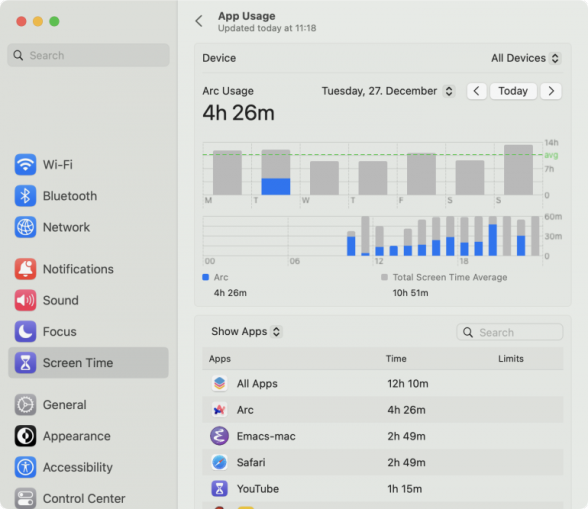
Unfortunately Screen Time will only let you view the time you’ve spent on specific websites in Safari, not on other browsers. If you’re looking for this level of granular detail, Timing can help you out. It tracks the individual websites you visit across all the browsers you use.
Getting Deeper App Usage Insights with Timing
While Screen Time provides basic information about your Mac app usage, many users find themselves asking: “How can I see how much time I spend in each Mac app?” with more granular detail than what Apple’s built-in tool offers. This is where Timing excels. Unlike Screen Time’s broad categories and basic app summaries, Timing automatically logs detailed time spent in every app, document, and website you use throughout your day. Rather than just seeing that you spent “4 hours in Microsoft Excel,” Timing shows you exactly which spreadsheets you worked on, when you switched between documents, and how your time was distributed across specific tasks.
Timing’s Activities tab provides a comprehensive view of your per-app usage in real-time, displaying not just which apps you’ve used, but also the specific documents, websites, and activities within each application. This level of detail makes it invaluable for professionals who need to track billable hours, understand their productivity patterns, or simply gain better awareness of where their time actually goes. Timing’s AI summaries feature, is also accessible directly from the Activities tab. This AI feature automatically analyzes your time data to deliver instant insights about your work patterns and productivity trends without requiring manual review.
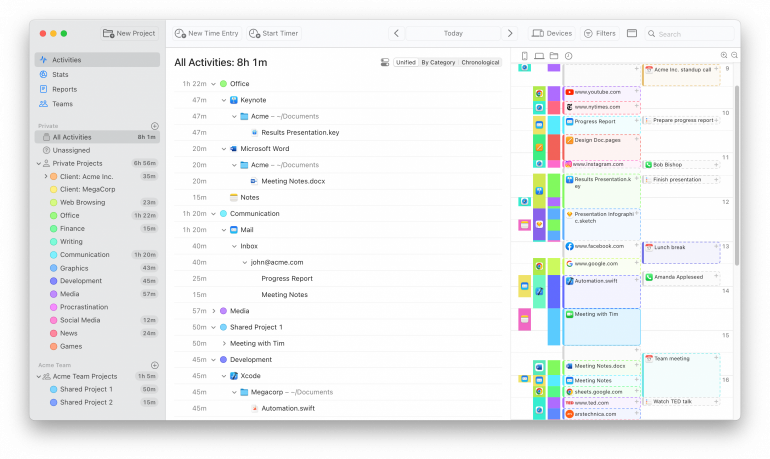
The automatic tracking means you never have to remember to start or stop a timer. Timing captures everything in the background while you focus on your work. When you’re ready to review your time, you’ll have a complete, accurate picture of your digital activity that goes far beyond what Screen Time can provide.
Taking Mac Screen Time to the next level
Already using Screen Time on Mac and wondering if you’re getting the most out of it? These tips might help you:
1. Sync your time across multiple devices
Your Mac doesn’t have a monopoly on your working time. In fact, most of us do an enormous amount of work on the run. We have work phone calls while we’re running errands, and respond to emails on our iPad while we’re attending our kid’s track meet.
By clicking “Share across devices”, you can sync your Screen Time usage data across multiple devices. (Be warned, this total time might show just how little time you’re spending away from your devices. If this is the case, don’t forget to seek out some work-life balance.)
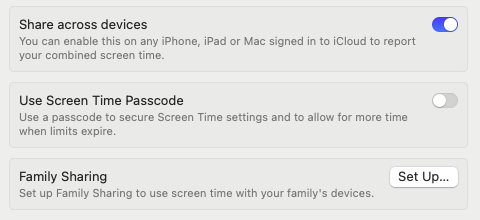
It’s important to note that Timing’s new Screen Time integration means that you can now integrate the time you spend on your iPhone and iPad straight into Timing. This ensures that no Slack message, email, or phone call gets missed from your time log, no matter where you are.
2. Oversee your kids’ screen time
One of the biggest advantages of Screen Time is that you can use it to monitor your children’s device usage, and which apps they have access to.
Curious about how to set up parental controls using Screen Time? Simply select “Family Sharing” in your Screen Time menu, and connect your children’s devices. You can add another adult as a parent or guardian if you wish.
 Image source: Kelly Sikkema
Image source: Kelly Sikkema
3. Manage your content and privacy
Screen Time also allows you to set privacy settings for certain apps, stores and content. This can help to protect you — and especially your children — from explicit, inappropriate or unwanted content.
4. Turn Screen Time off
You don’t have to have Screen Time on all the time. Having it on while you’re enjoying a Sunday afternoon Netflix marathon will likely throw your stats out. If you’re wondering how to turn off Screen Time on your Mac, simply toggle the button in System Preferences again. But be sure to turn it back on when you want to get back to monitoring your time.
If you’re supplementing Screen Time with Timing, you can simply establish a rule that all Netflix time simply becomes part of a project you call “entertainment”. Everyone needs some time to relax, after all.
The benefits and limitations of Screen Time for Mac
Screen Time for Mac is a useful tool, but it’s not without its limitations. And the more you use it, the clearer it might become that Screen Time probably isn’t robust enough to be your only time management tool.
The perks
Here are some of Screen Time’s key benefits:
- Syncing Screen Time across all your devices can give you valuable oversight into how you spend your time
- Setting limits can be help you focus and be more productive
- It gives you control over how your children use their devices
The downsides
Screen Time offers all of these things, but it really doesn’t get into the nitty gritty. It can tell you that you spent 4h 22m on Microsoft Excel, but not precisely which spreadsheets you were focusing on. You might have looked at a budget for one client, a schedule for another, and developed some graphs for a third. If these are hours you’re billing, the specifics matter.
It doesn’t allow you to manually enter time that you spent away from your computer, such as attending a lunch engagement with a client. It also won’t detect when you’re in a virtual meeting, and remind you to allocate it to a specific client or project.
If you’re using Screen Time Mac to get detailed insight into your time so that you can manage your time effectively, and especially if it’s part of running your business, you’re likely to find it wanting. That’s where an app like Timing can help. Timing documents every single app, document, and website you use, so that this usage can be individually recorded, and ultimately inform your billing.
![]()
Supplement Screen Time with Timing
Mac Screen Time has its place, but it’s best to see it as a helpful addition to your formal time tracking software, rather than a complete solution.
Use App Limits and Downtime to establish some structure for yourself. But use Timing to get detailed information on all the apps, documents and websites you use, so that you can allocate your time properly and bill for it accurately. Remember that Timing’s also fully customizable, so you can create a hierarchy of projects and structure your workflow in ways that make sense for you. And you can enter data manually, so that no piece of work, no matter where you do it or what device you do it on, gets missed.
Of course, Timing also integrates seamlessly across iPhones and iPads, so many of these entries won’t need to be manual at all. While Screen Time has the capacity to sync data across devices, too, Timing’s approach is much more accurate as it doesn’t double-count time spent on certain websites or apps. It also doesn’t count time when an app is fetching data in the background.
With all this valuable insight, you’re well on your way to boosting your productivity, sharpening your focus, strengthening your bottom line, and having some time for that occasional Netflix marathon, too.
Start keeping track of your time properly today. Download Timing’s 30-day trial for free.
Frequently Asked Questions
Curious about how Screen Time for Mac works and how you can use it to your advantage? Let’s finish by answering a few frequently asked questions:
How can I check what apps are using most of my Mac screen time?
It’s a great idea to keep tabs on your screen time. Apple’s time tracking feature, Screen Time, gives you a high-level overview of the apps you’re using the most. That said, Screen Time only gives you a basic overview. If you want more details, consider a dedicated time-tracking app like Timing for Mac.
How do I view my Screen Time Mac usage statistics?
Using Screen Time is easy. Simply click on “Screen Time” on your Mac’s System Preferences, and select “App Usage”. This will tell you which apps you’ve been using the most, and how much time you’re spending on them every day. Note that your Screen Time stats only cover the last four weeks. An app like Timing can store your history for longer and provides more details.
How do I set app limits or schedule downtime using Screen Time on Mac?
Both “App Limits” and “Downtime” can be found on the Screen Time menu — just below “App Usage.” Simply select “Add Limit” to choose the apps you would like to limit, and schedule downtime by designating a certain period.
How do I see hours on my Mac?
Screen Time is a great way to see how much time you’re spending on your Mac. Simply click on “Screen Time” on your Mac’s System Preferences, and select “App Usage”. This will tell you which apps you’ve been using the most, and how much time you’re spending on them every day. If you need more details or want to track time spent on specific projects, consider a dedicated time-tracking app like Timing for Mac.
